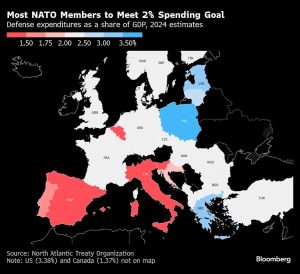Delray Beach, FL, Jan. 24, 2025 (GLOBE NEWSWIRE) — The global AI medical imaging market, valued at US$1.29 billion in 2023, is forecasted to grow at a robust CAGR of 22.4%, reaching US$1.65 billion in 2024 and an impressive US$4.54 billion by 2029. The factors driving the market growth include increasing government initiatives on AI-based technologies, higher funding for AI startups, a massive inflow of big data, and growing cross-industry collaborations. The market offers significant opportunities, particularly in untapped emerging markets such as Latin America, Southeast Asia, and Africa, where expanding healthcare infrastructure creates demand for cost-effective, AI-powered diagnostic solutions. Furthermore, a focus on developing human-aware AI systems that align with clinician decision-making and provide interpretable, patient-centred insights is immense to foster trust and adoption in medical settings. AI’s capability to enhance early detection, automate imaging workflows, and integrate with advanced imaging modalities positions it as a transformative force in improving diagnostic accuracy and healthcare outcomes globally.
Download PDF Brochure: https://www.marketsandmarkets.com/pdfdownloadNew.asp?id=21977207
Browse in-depth TOC on “AI in Medical Imaging Market“
400 – Tables
176 – Figures
500 – Pages
However, there are challenges in the form of a shortage of skilled AI professionals and ambiguous regulatory frameworks that are expected to slow growth to some extent.
Based on components, the market is segmented into software, services, and hardware. The software segment dominated in 2023 due to its ability to handle large datasets, seamless integration with clinical workflows, and customized solutions in areas such as radiology and pathology. Scalability and flexibility of AI software and feature such as cloud-based updating with remote access enhance diagnosis precision and efficiency, acting as a critical enabler of advancing AI-powered medical imaging. The software segment is dominated even though the services segment will lead in terms of CAGR, from 2023 through 2029. Increased demand for implementation, training, and support services can be seen as essential integration components of AI solutions into healthcare systems. Hardware also complements these segments by providing high-speed data processing and storage, which is extremely critical for AI applications. Despite these challenges, technological advancements continue to grow while efforts to address regulatory and workforce barriers are on the increase.
Based on Application, The AI in medical imaging market is divided into radiology, cardiology, oncology, neurology, orthopedics, obstetrics and gynecology, and other applications. In these, radiology leads with the largest market share as it is the most crucial part of diagnostic imaging, and the adoption of AI-based solutions early for enhancing image analysis, workflow efficiency, and decreasing errors in diagnosis. Advances in modalities such as X-rays, CT scans, and MRIs driven by AI have cemented radiology as a core segment in the market. On the other hand, the oncology segment is growing rapidly with the increase in the prevalence of cancer and the need for AI tools to assist in early detection, tumor characterization, and personalized treatment planning. The ability of AI to improve precision in oncology imaging, combined with the rising investments into research and development, is driving significant expansion in this segment.
The AI in medical imaging market is segmented by end users into hospitals and surgical centers, diagnostic imaging centers, and others. Hospitals and surgical centers lead the market, driven by their capacity to manage high patient volumes, access to substantial funding, and the necessity for integrated AI solutions to address complex, multi-specialty cases. These facilities often serve as the primary point of care, leveraging AI to improve workflow efficiency, reduce diagnostic errors, and enhance clinical decision-making. On the other hand, diagnostic imaging centers are growing rapidly due to their increasing focus on specialized imaging services and faster turnaround times. These centers are embracing AI to automate image analysis, optimize resource utilization, and offer cost-effective solutions, making them attractive for outpatient services and patients seeking quicker diagnostics. Additionally, the trend of decentralizing healthcare and the proliferation of AI-powered imaging tools tailored for standalone centers contribute to the growth of diagnostic imaging centers.
Based on region, the AI in medical imaging market is segmented into North America, Europe, Asia Pacific, Latin America, and the Middle East & Africa. In 2023, North America dominated the market due to its advanced healthcare infrastructure, substantial investments in AI, and early adoption of AI-powered technologies. The region’s focus on innovation and a strong network of AI startups further contribute to its leadership.
The Asia Pacific region is anticipated to register the highest CAGR during the forecast period, fueled by significant advancements in healthcare infrastructure, a growing elderly population, and government initiatives in countries such as China and India to encourage AI adoption in medical imaging. Additionally, emerging markets in Asia Pacific offer significant opportunities as healthcare providers increasingly adopt AI solutions to enhance diagnostic accuracy, improve efficiency, and meet the rising demand for quality care.
Request Sample Pages : https://www.marketsandmarkets.com/requestsampleNew.asp?id=21977207
The medical imaging market is largely dominated by several major global corporations, which account for a large share. However, some SMEs and regional companies also occupy a considerable share of the market. The key players in the AI in medical imaging market include Microsoft (US), Merative (US), NVIDIA Corporation (US), Siemens Healthineers (Germany), Intel Corporation (US), Google (US), GE Healthcare (US), Digital Diagnostics Inc. (US), InformAI (US), HeartFlow, Inc. (US), Advanced Micro Devices, Inc. (US), Enlitic, Inc. (US), icometrix (Belgium), Aidence (Netherlands), and Butterfly Network.
Microsoft (US)
Microsoft is considered one of the major firms in the artificial intelligence-driven market for medical image analysis. The company strongly invests in research and development, expanding its product list and providing it with high ground at the AI forefront. Currently, Microsoft targets four subdomains of Artificial Intelligence as focus areas- machine learning, deep learning, NLP as well as SR. However, the strength of Organic growth can further be appreciated by looking toward the Azure Machine Learning (AML).
In 2024, Microsoft will further its collaboration with NVIDIA, combining Azure’s cloud and AI capabilities with NVIDIA’s DGX Cloud and Clara suite, which is expected to increase the pace of innovation for clinical research, drug discovery, and medical imaging diagnostics and speed up the way to patient care. In addition, in 2023, Microsoft announced a collaboration with Paige AI, Inc. to create the world’s largest models of AI for digital pathology and oncology. This promises to revolutionize cancer diagnosis and patient care by employing powerful AI technologies.
NVIDIA CORPORATION (US)
NVIDIA Corporation ranks second in the AI medical imaging market, largely because of its position as a leading provider of GPUs for training and executing ML and AI algorithms. The company has strong presence across multiple geographies and works with top OEMs/ODMs globally. NVIDIA consistently drives innovation and expands its portfolio in the AI market.
For instance, in September 2022, NVIDIA announced the NVIDIA IGX platform, which aims to enable businesses to design next-generation, software-defined industrial and medical devices that can operate safely alongside humans. The platform includes the NVIDIA IGX Orin, a compact, powerful, energy-efficient AI supercomputer specifically designed for autonomous industrial equipment and medical devices. NVIDIA’s platforms include the DGX AI and various GPUs, accelerating deep neural networks and machine learning for healthcare applications. The company has more than 50 offices spread over the Americas, Asia, and Europe and, with strategic inorganic growth, has secured its leading position in the AI medical imaging market.
GOOGLE (US)
Google has emerged as a leader in integrating artificial intelligence (AI) into medical imaging, particularly in enhancing the efficiency and accuracy of diagnostics. Its AI-powered Medical Imaging Suite enables faster diagnoses and improved patient care by leveraging cutting-edge AI algorithms. The suite is designed to make imaging data more accessible, interoperable, and useful across various healthcare settings, enabling seamless integration with cloud, on-premises, or edge storage systems. Google Cloud’s AI capabilities, enhanced by collaborations with industry leaders like NVIDIA, help automate complex image analysis tasks, accelerating the development of scalable AI models and transforming the way medical images are analyzed and interpreted. By making powerful AI tools more accessible, Google is driving advancements in medical imaging that can ultimately improve outcomes and reduce the burden on healthcare professionals.
For more information, Inquire Now!
Related Reports:
Refurbished Medical Equipment Market
Artificial Intelligence in Medical Diagnostics Market
Medical Equipment Maintenance Market
Medical Device Connectivity Market
Top 10 Medical Device Technologies Market
Get access to the latest updates on AI in Medical Imaging Companies and AI in Medical Imaging Market Size

About MarketsandMarkets™ MarketsandMarkets™ has been recognized as one of America's best management consulting firms by Forbes, as per their recent report. MarketsandMarkets™ is a blue ocean alternative in growth consulting and program management, leveraging a man-machine offering to drive supernormal growth for progressive organizations in the B2B space. We have the widest lens on emerging technologies, making us proficient in co-creating supernormal growth for clients. Earlier this year, we made a formal transformation into one of America's best management consulting firms as per a survey conducted by Forbes. The B2B economy is witnessing the emergence of $25 trillion of new revenue streams that are substituting existing revenue streams in this decade alone. We work with clients on growth programs, helping them monetize this $25 trillion opportunity through our service lines - TAM Expansion, Go-to-Market (GTM) Strategy to Execution, Market Share Gain, Account Enablement, and Thought Leadership Marketing. Built on the 'GIVE Growth' principle, we work with several Forbes Global 2000 B2B companies - helping them stay relevant in a disruptive ecosystem. Our insights and strategies are molded by our industry experts, cutting-edge AI-powered Market Intelligence Cloud, and years of research. The KnowledgeStore™ (our Market Intelligence Cloud) integrates our research, facilitates an analysis of interconnections through a set of applications, helping clients look at the entire ecosystem and understand the revenue shifts happening in their industry. To find out more, visit www.MarketsandMarkets™.com or follow us on Twitter, LinkedIn and Facebook. Contact: Mr. Rohan Salgarkar MarketsandMarkets Inc. 1615 South Congress Ave. Suite 103, Delray Beach, FL 33445 USA : 1-888-600-6441 UK +44-800-368-9399 Email: sales@marketsandmarkets.com Visit Our Website: https://www.marketsandmarkets.com/
© 2025 Benzinga.com. Benzinga does not provide investment advice. All rights reserved.



